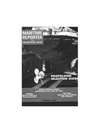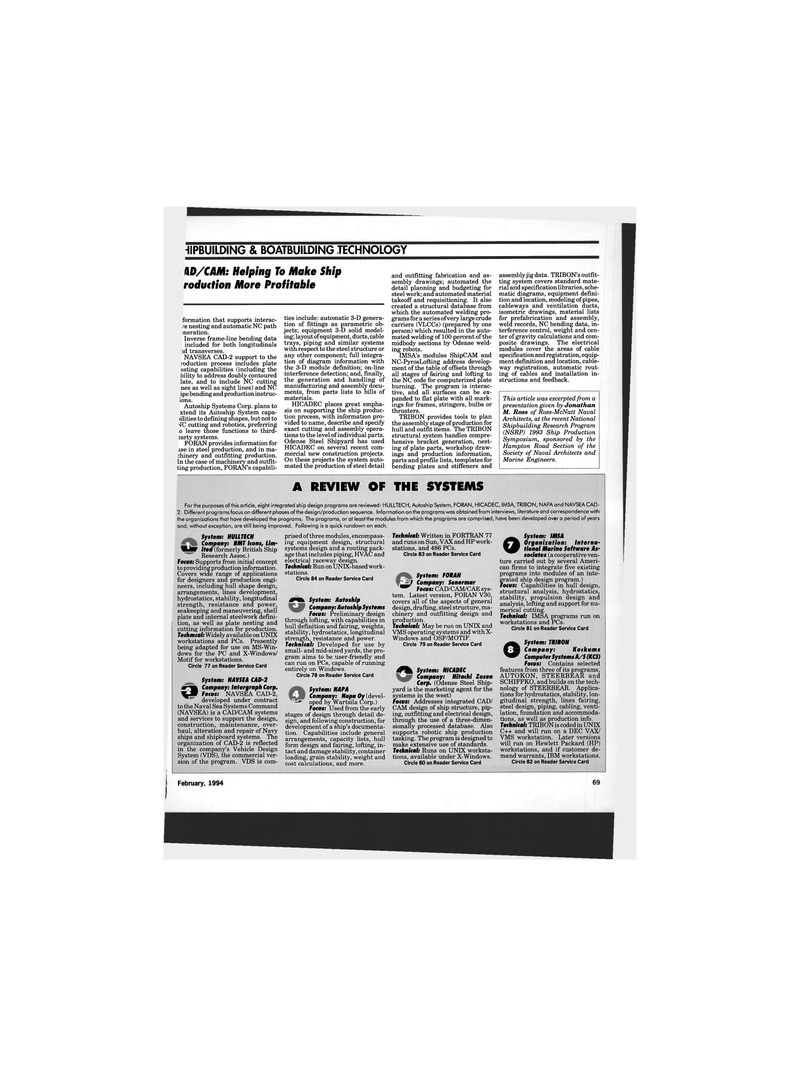
Page 59: of Maritime Reporter Magazine (February 1994)
Read this page in Pdf, Flash or Html5 edition of February 1994 Maritime Reporter Magazine
-UPBUILDING & BOATBUILDING TECHNOLOGY
AD/CAM: Helping To Make Ship rodu€tion More Profitable formation that supports interac- re nesting and automatic NC path ineration.
Inverse frame-line bending data included for both longitudinals id transverses.
NAVSEA CAD-2 support to the reduction process includes plate esting capabilities (including the bility to address doubly contoured late, and to include NC cutting nes as well as sight lines) and NC ipe bending and production instruc-
Lons.
Autoship Systems Corp. plans to xtend its Autoship System capa- cities to defining shapes, but not to 4C cutting and robotics, preferring .0 leave those functions to third- 3arty systems.
FORAN provides information for lse in steel production, and in ma- chinery and outfitting production.
In the case of machinery and outfit- ting production, FORAN's capabili- ties include: automatic 3-D genera- tion of fittings as parametric ob- jects; equipment 3-D solid model- ing; layout of equipment, ducts, cable trays, piping and similar systems with respect to the steel structure or any other component; full integra- tion of diagram information with the 3-D module definition; on-line interference detection; and, finally, the generation and handling of manufacturing and assembly docu- ments, from parts lists to bills of materials.
HICADEC places great empha- sis on supporting the ship produc- tion process, with information pro- vided to name, describe and specify exact cutting and assembly opera- tions to the level of individual parts.
Odense Steel Shipyard has used
HICADEC on several recent com- mercial new construction projects.
On these projects the system auto- mated the production of steel detail and outfitting fabrication and as- sembly drawings; automated the detail planning and budgeting for steel work; and automated material takeoff and requisitioning. It also created a structural database from which the automated welding pro- grams for a series of very large crude carriers (VLCCs) (prepared by one person) which resulted in the auto- mated welding of 100 percent of the midbody sections by Odense weld- ing robots.
IMSA's modules ShipCAM and
NC-PyrosLofting address develop- ment of the table of offsets through all stages of fairing and lofting to the NC code for computerized plate burning. The program is interac- tive, and all surfaces can be ex- panded to flat plate with all mark- ings for frames, stringers, bulbs or thrusters.
TRIBON provides tools to plan the assembly stage of production for hull and outfit items. The TRIBON structural system handles compre- hensive bracket generation, nest- ing of plate parts, workshop draw- ings and production information, parts and profile lists, templates for bending plates and stiffeners and assembly jig data. TRIBON's outfit- ting system covers standard mate- rial and specification libraries, sche- matic diagrams, equipment defini- tion and location, modeling of pipes, cable ways and ventilation ducts, isometric drawings, material lists for prefabrication and assembly, weld records, NC bending data, in- terference control, weight and cen- ter of gravity calculations and com- posite drawings. The electrical modules cover the areas of cable specification and registration, equip- ment definition and location, cable- way registration, automatic rout- ing of cables and installation in- structions and feedback.
This article was excerpted from a presentation given by Jonathan
M. Ross of Ross-McNatt Naval
Architects, at the recent National
Shipbuilding Research Program (NSRP) 1993 Ship Production
Symposium, sponsored by the
Hampton Road Section of the
Society of Naval Architects and
Marine Engineers.
A REVIEW OF THE SYSTEMS
For the purposes of this article, eight integrated ship design programs are reviewed: HULLTECH, Autoship System, FORAN, HICADEC, IMSA, TRIBON, NAPA and NAVSEA CAD- 2. Different programs focus on different phases of the design/production sequence. Information on the programs was obtained from interviews, literature and correspondence with the organizations that have developed the programs. The programs, or at least the modules from which the programs are comprised, have been developed over a period of years and, without exception, are still being improved. Following is a quick rundown on each.
System: HULLTECH
Company: BMT Icons, Lim-
Wm ited (formerly British Ship
Research Assoc.)
Focus: Supports from initial concept to providing production information.
Covers wide range of applications for designers and production engi- neers, including hull shape design, arrangements, lines development, hydrostatics, stability, longitudinal strength, resistance and power, seakeeping and maneuvering, shell plate and internal steelwork defini- tion, as well as plate nesting and cutting information for production.
TechmcahWidely available on UNIX workstations and PCs. Presently being adapted for use on MS-Win- dows for the PC and X-Windows/
Motif for workstations.
Circle 77 on Reader Service Card
System: NAVSEA CAD-2 'rm Company: Intergraph Corp. \M Focus: NAVSEA CAD-2, developed under contract to the Naval Sea Systems Command (NAVSEA) is a CAD/CAM systems and services to support the design, construction, maintenance, over- haul, alteration and repair of Navy ships and shipboard systems. The organization of CAD-2 is reflected in the company's Vehicle Design
System (VDS), the commercial ver- sion of the program. VDS is com- prised of three modules, encompass- ing equipment design, structural systems design and a routing pack- age that includes piping, HVAC and electrical raceway design.
Technical: Run on UNIX-based work- stations.
Circle 84 on Reader Service Card i k System: Autoship
Company: Autoship Systems
Focus: Preliminary design through lofting, with capabilities in hull definition and fairing, weights, stability, hydrostatics, longitudinal strength, resistance and power.
Technical: Developed for use by small- and mid-sized yards, the pro- gram aims to be user-friendly and can run on PCs, capable of running entirely on Windows.
Circle 78 on Reader Service Card
System: NAPA
Company: Napa Oy (devel- '- ' oped by Wartsila Corp.)
Focus: Used from the early stages of design through detail de- sign, and following construction, for development of a ship's documenta- tion. Capabilities include general arrangements, capacity lists, hull form design and fairing, lofting, in- tact and damage stability, container loading, grain stability, weight and cost calculations, and more.
Technical: Written in FORTRAN 77 and runs on Sun, VAX and HP work- stations, and 486 PCs.
Circle 83 on Reader Service Card
System: FORAN '*..- Company: Senermar ^ Focus: CAD/CAM/CAE sys- tem. Latest version, FORAN V30, covers all of the aspects of general design, drafting, steel structure, ma- chinery and outfitting design and production.
Technical: May be run on UNIX and
VMS operating systems and with X-
Windows and OSF/MOTIF.
Circle 79 on Reader Service Card i % System: HICADEC
Company: Hitachi Zosen
Corp. (Odense Steel Ship- yard is the marketing agent for the systems in the west)
Focus: Addresses integrated CAD/
CAM design of ship structure, pip- ing, outfitting and electrical design, through the use of a three-dimen- sionally processed database. Also supports robotic ship production tasking. The program is designed to make extensive use of standards.
Technical: Runs on UNIX worksta- tions, available under X-Windows.
Circle 80 on Reader Service Card 0 System: IMSA Organization: Interna-tional Marine Software As-sociates (a cooperative ven- ture carried out by several Ameri- can firms to integrate five existing programs into modules of an inte- grated ship design program.)
Focus: Capabilities in hull design, structural analysis, hydrostatics, stability, propulsion design and analysis, lofting and support for nu- merical cutting.
Technical: IMSA programs run on workstations and PCs.
Circle 81 on Reader Service Card ^^ System: TRIBON pa Company: Kockums ^^ Computer Systems A/S(KCS)
Focus: Contains selected features from three of its programs,
AUTOKON, STEERBEAR and
SCHIFFKO, and builds on the tech- nology of STEERBEAR. Applica- tions for hydrostatics, stability, lon- gitudinal strength, lines fairing, steel design, piping, cabling, venti- lation, foundation and accommoda- tions, as well as production info.
Technical: TRIBON is coded in UNIX
C++ and will run on a DEC VAX/
VMS workstation. Later versions will run on Hewlett Packard (HP) workstations, and if customer de- mand warrants, IBM workstations.
Circle 82 on Reader Service Card
February, 1994 113

 58
58

 60
60
